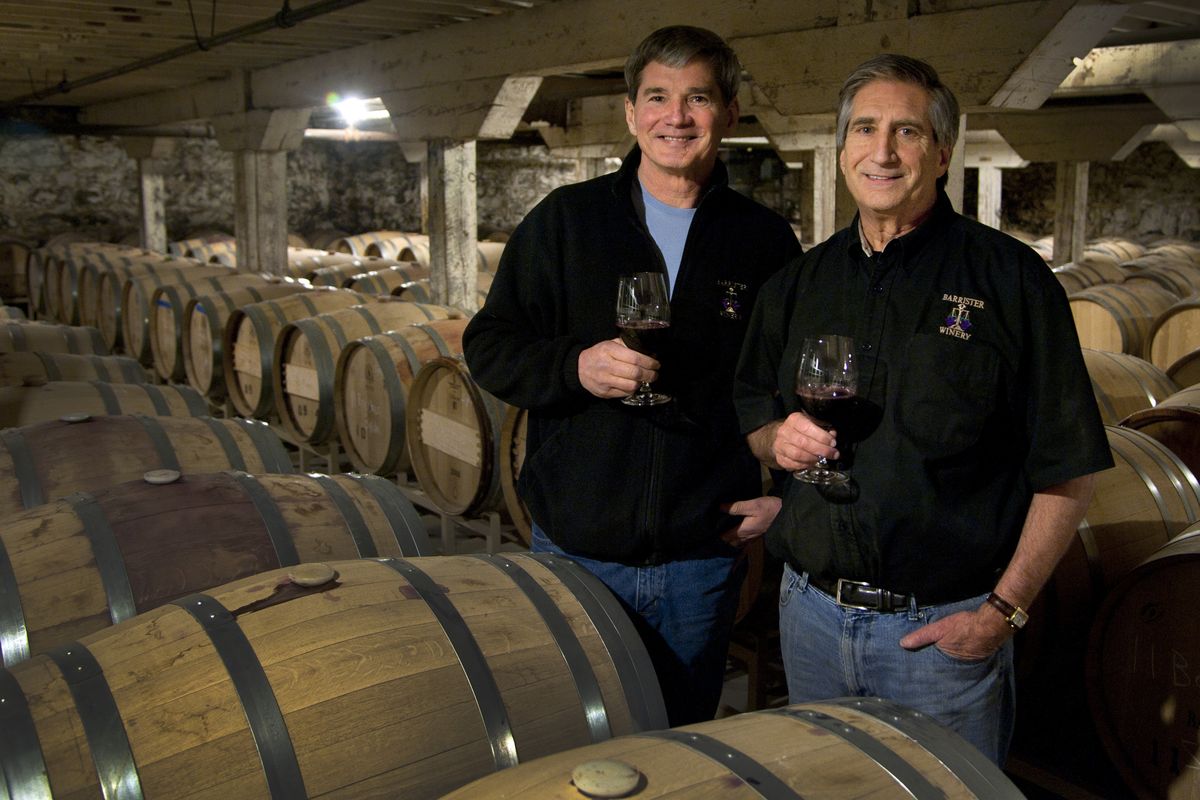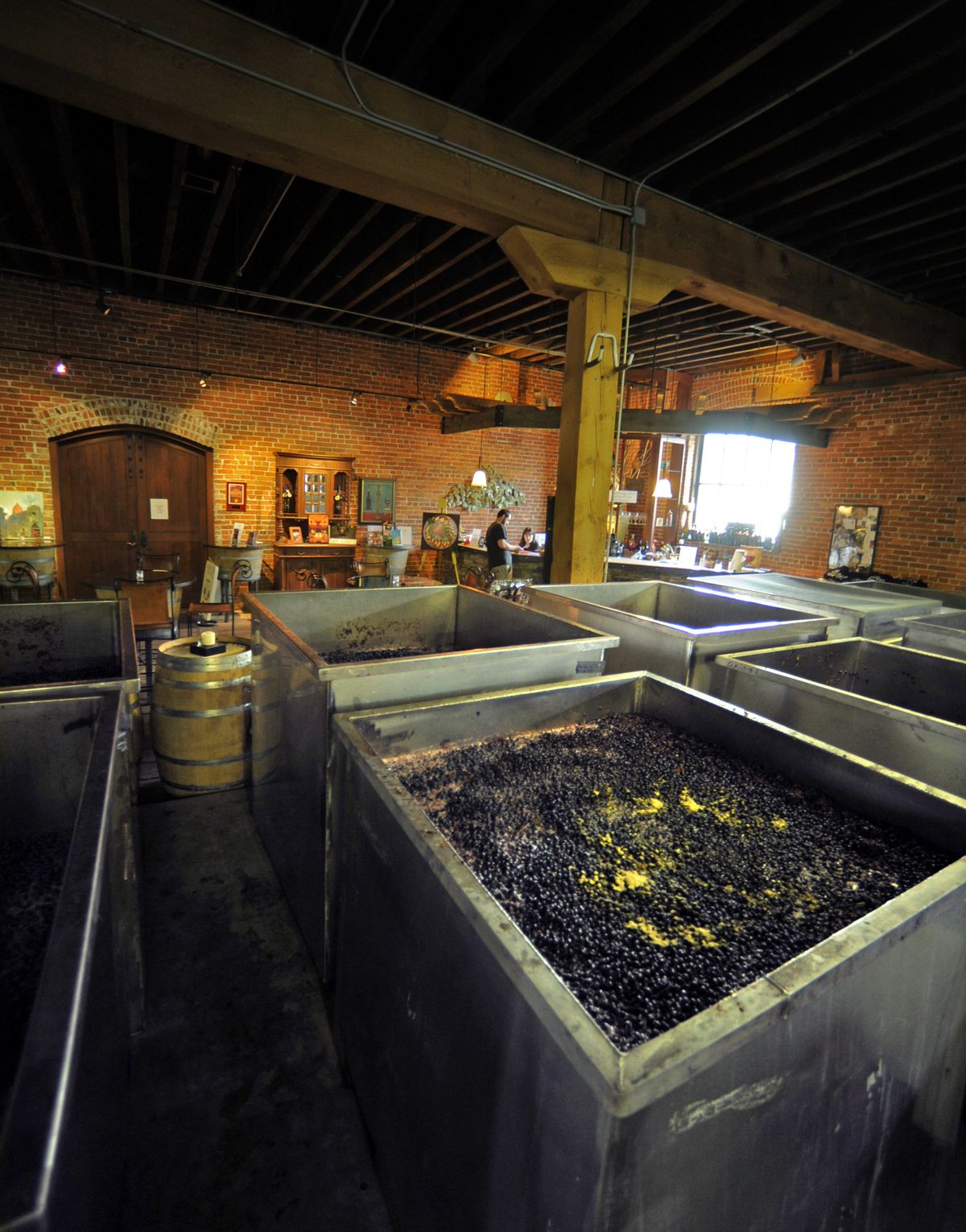‘A whole new dynamic of wine’
Barrister partners started as hobbyists
Michael White, left, and Greg Lipsker own Barrister Winery. (Colin Mulvany)Buy a print of this photo
Fifteen years ago while vacationing with their families, buddies Greg Lipsker and Michael White bought a five-gallon winemaking kit on a whim.
“We followed all of the instructions,” recalled White, “and were so proud of that first batch.” But his wife declared it “really unremarkable.”
Ouch.
Undeterred, the two attorneys and fellow oenophiles read books, took classes and called in a favor to secure premium grapes.
The pair’s efforts were rewarded when their 2002 Cabernet Franc won best of show at the Los Angeles County Fair Wines of the World Competition.
More honors followed. Last month, the trade publication Wine Business Monthly included their cabernet franc on its list of 10 hot small brands.
During an interview in their cavernous tasting room, Lipsker and White, who still practice law part time, recalled how their hobby evolved into Barrister Winery.
S-R: What was your earliest winemaking experience?
White: I wouldn’t call it experience, but in college we made wine by putting juice in a bottle and putting a balloon on top. As a matter of fact, I think I poured that out.
Lipsker: I was a student of wine for 30 years before we bought the kit. Michael and I were both avid wine drinkers and collectors. I’d gone to France and taken a short course in winemaking, but not with the vision of ever opening a winery. It was just to learn more about wine.
S-R: Why winemaking as a hobby, as opposed to, say, beekeeping?
Lipsker: A lot of how Michael and I became best friends was through sharing wine and traveling to various wine-tasting events. That first kit gave us an opportunity to explore a whole new dynamic of wine.
S-R: How did your winemaking rise from unremarkable to award-winning?
White: We read publications about how to make wine. We took a quick course from Jim’s Home Brew, where we went through step by step using frozen fruit from the grocery store. Greg took an Internet course from UC Davis. But it was really trial and error, and eventually some mentoring.
S-R: Tell me about that connection.
Lipsker: I took my first wine-appreciation class in 1972 in the underground university at Gonzaga, taught by Myles Anderson, the dean of students. Twenty-three years later, I did the legal work to set up Walla Walla Vintners (for owners Anderson and Gordon Venneri). Then in the late ’90s, when Michael and I decided we wanted to make wine from grapes instead of juice, we contacted Myles, went down to Walla Walla and came back with 700 pounds of grapes from a fabulous vineyard. So as home winemakers, we had access to some of the finest fruit in the state.
White: We bought a number of carboys – those 5-gallon glass jars – and were trying a little bit of everything. We had oak cubes and staves that we immersed in the wine to give it that oakiness, because we didn’t have the quantity to justify barrels. And we experimented with different grapes and yeasts.
S-R: When did you start taking yourselves seriously as winemakers?
Lipsker: By 2000, we were crushing a ton and a half of grapes in my garage, and we thought the wines we were making were pretty good. But we really didn’t know. So we found a competition back in Indiana – the Indy International Wine Competition, in conjunction with the Purdue ag school – and we sent four of our wines back there. We won three golds and a silver, and that gave us the confidence to think we were on the right track.
S-R: What did it take to launch the winery?
White: It took Greg’s knowledge of the licensing process. The other thing was sourcing fruits from vineyards, and that’s where Myles Anderson came in again – pointing us toward vineyards where we could buy a ton of grapes.
Lipsker: The key to being a successful winery is having access to excellent fruit. There’s a saying that 80 percent of the wine is made in the vineyard.
S-R: What was your first commercial success?
Lipsker: Our 2002 Cabernet Franc that won best of show at the L.A. Wines of the World Competition. At the time, that was the largest competition in the country, and to win best of show with the second wine we ever released was quite a feather in our cap.
S-R: Where did you go from there?
Lipsker: The next year, we won best of show at the Northwest Wine Summit, which represents 1,200 wines from Washington and Oregon. The following year, the cab franc won best of show at the Tri-Cities Wine Festival. I think the three years in a row – that consistency – is what really got us noticed.
S-R: Where do you get your cabernet franc grapes?
Lipsker: From Chelle den Pleasant, a magical little vineyard in Prosser (Wash.). Back when we were home winemakers, we bought 500 pounds of grapes from them. Now we buy six of their eight acres.
S-R: You went from a 1,500-square-foot facility to over 26,000. Will you eventually outgrow your present building?
Lipsker: Our plan is to stay at this level. If we were to grow, we’d have to triple in size to have it make sense, and that’s not the business we want. Besides, our facility is like no other in Spokane. There are a lot of great wines made in the state. But when people come here, it’s the Barrister experience that sets us apart.
S-R: What do you like most about winemaking?
Lipsker: I like that I started a business with my best friend, and 10 years later we have something successful, and we’re still best friends.
White: I would agree with that. And the other thing I enjoy is the people we meet. Wine drinkers are just a wonderful group.
S-R: Do you visit other wineries to get ideas?
Lipsker: I think it’s important that we travel around for two reasons. One is to taste other wines to see what people are producing. And I think it’s really important to be on the other side of the tasting bar, so that we remain a cut above the experience people have at other wineries.
S-R: Any changes on the horizon?
White: I think we’ll grow our production a few hundred cases. I can see us looking at some other varietals. It’s always nice to try something different and have a new wine out there every now and again. But I don’t see us changing significantly.
Lipsker: We’re always looking for ways to upgrade our facility. We’ll probably do 70 events here this year – wedding receptions, rehearsal dinners, corporate gathering, holiday parties. We’re talking about changing our courtyard to allow us to host outside events.
S-R: What advice would you offer someone who dreams of starting a winery?
White: It was good for us to start small and work up. It’s a very expensive proposition. If you’re making red wines, it takes two to three years to get something to the market. My advice is to go with your heart, but do it on an incremental basis.
Lipsker: Strive for excellence. And make sure everyone who comes into your winery leaves with a personal connection.

